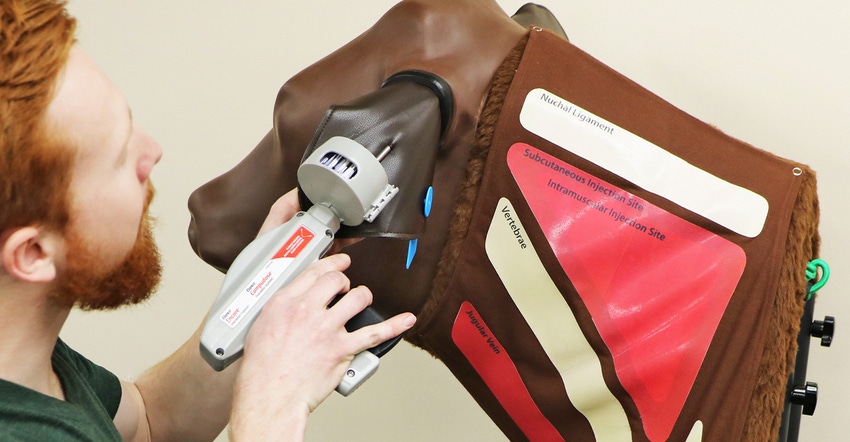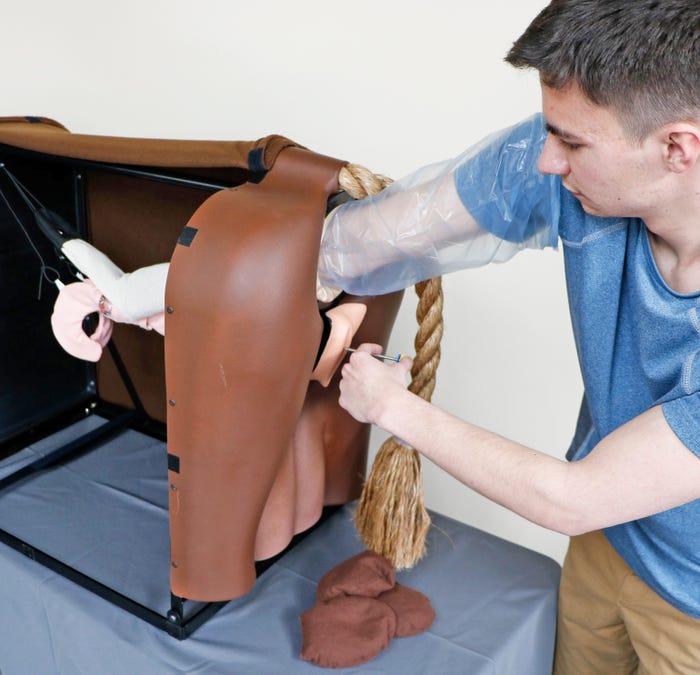November 19, 2019

The days of the high-school field trip to the farm may be numbered. Or more limited. With falling budgets and rising concerns over liability, students don't get the same "real-world" chance to engage with agriculture on a deeper level than a corn maze.
Yet agriculture offers opportunities for future high school and college grads in a range of industry roles. What's a teacher to do?
For agriculture teachers at the high school level, new tools are opening opportunities for teaching and informing students about agriculture. One tool is a simulator, which can offer students a noninvasive experience, yet provide real-world benefits.
"I use the AI simulator," says William Fritz, Mount Pleasant High School agriculture education instructor, Rolla, N.D. "We're in an area where there isn't a lot of livestock. I have 69 students and only four have livestock; they're mostly grain farmers."
Fritz notes that Rolla has 1,300 residents, and there are many even in the small town who have never been near a cow. And with fewer cattle in the area, providing students access is a challenge. "It's easier to [use the simulator] than trying to line up a farmer that allows us to practice AI in their cattle."
The simulator Fritz acquired is from Realityworks, an Eau Claire, Wis., company that makes training tools for health science, agriculture and other career and technical education programs. The AI simulator, or Bovine Breeder as it's called, and the Bovine Injection simulator, offer students the chance to try out artificial insemination or ear tagging in a way that's educational and risk-free.
For Fritz, the simulator — which is a life-size cow rear end in his classroom — is a way to keep students engaged. When it first arrived, there were the occasional snickers and bawdy comments, but as students get more engaged, Fritz says they're learning a real-world skill.
"Most of the cattle producers around here use bulls," he says. "When I teach the AI unit, I share that this is a career where you can make a living. Many don't have a clue that an [AI tech] is an actual job."

AI TRAINING: Artificial insemination has potential as an ag-related job opportunity, and high school agriculture instructors see the value.

Getting past the ick factor
A simulator is a simple way to avoid some of the challenges of working with actual cattle. Yet Fritz informs even the novice student that the simulator is a tool, and that working live animals can be different. However, he also notes that the simulator is accurate when it comes to AI training.
"I've had experienced people check it out, and they tell me it's very real," he says.
And that's what Whitney Judd, Coalmont, Tenn., a CTE teacher in agriculture, is finding out with the two Realityworks units she has in her classroom. Both the Bovine Breeder and the Bovine Injection Simulator are available to her class.
"With the injection simulator, you use water in a syringe — and you can keep reusing those, and the ear tags," she notes. "Students can learn that skill."
Noting that Grundy County is an economically disadvantaged area of Tennessee, any insight into jobs has value. Yet Judd ran into the problem of not being able to take students to farms for practice. Like Fritz, she needed an alternative.
Judd's school has a career in tech education program, and a Perkins educational grant offers money for teaching tools. "I have a very proactive and supportive CTE director," she says. "She wants high-end, quality, top-notch supplies, and she wants our kids to get those experiences — to go out and be able to do better in society."
The Perkins grant is the Carl D. Perkins Career and Technical Act of 2006, which provides federal funding to states and discretionary grantees for improving secondary and postsecondary career and technical education programs. It's a source of outside funding teachers can access, provided they create a valid use case.
That CDT coordinator support and the Perkins grant helped Judd acquire the Realityworks tools. The higher upfront cost can challenge some schools, but teachers see the value. Add in the fact that you're not facing the liability of taking students off campus by bus to a busy farm with live animals, and these tools offer value.
Fritz also used Perkins grant funding to acquire that class's Bovine Breeder. "I knew that the money might be available, and I planned ahead to ask for it. I'd seen the system in a trade show," he says.
Hitting the sweet spot
"We've hit a need educators have," says Jamey McIntosh, Realityworks product marketing manager. "We continue to hear story after story about the need for students. Less come from the farm, and things you once assumed they knew or expected to understand, they don't. We have to go back and teach that stuff."
In a world where even small-town youth are more removed from the farm, dropping a cow reproductive system simulator in their midst can be a challenge. Fritz notes that he did have a couple male parents concerned about the simulator during conferences earlier in 2019. "But their wives told them to get over it," he says. "The kids are surprised about how artificial insemination actually works."
For McIntosh, the key to these products is their value in an education environment more directly concerned with STEM (science, technology, engineering and math) education. "This hits STEM because it has a big science component," he says. "For the breeder, there's the science of the reproduction cycle of the cow. For the injection simulator, they can learn about the process, but also about why cows are injected or tagged."
Judd notes she has her vice principal's sons in her class. "He's excited, and so are other parents," she says. "Kids graduate, then they come back; and when they see the simulator, they say wish they could have had that hands-on experience."
You can learn more about the tools at realityworks.com.
About the Author(s)
You May Also Like






